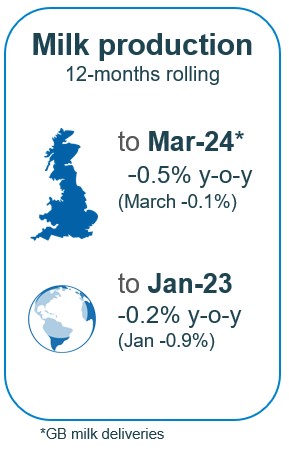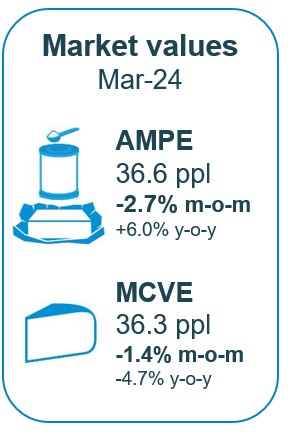Q1 2024 dairy market review
Thursday, 18 April 2024
Milk production
GB milk deliveries through Spring have been running fairly close to last year with March ending the month at only 0.1%, or 0.95 million litres down compared to last year. This means that if we compare 2023/24 on a 365-day equivalent, the total delivered volume for the milk year stands at 12.32 billion litres, a decline of 0.5% (63.60 million litres) on the previous year. This is the lowest milk-year volume recorded since the 2016/17 season.
While grass growth rates are reasonable, the ground is so wet we expect to see subdued production going into the flush as conditions delay turning out cows onto grass, with some concerns about the ability to carry out groundwork and the potential knock on effects on grass and silage quality for the coming season. This is reflected in the latest forecast as a marginal decline is expected in GB milk production for the 2024/25 season. Expectations are for more stable milk flows with a small decline of only 0.6%.
The milking herd has stabilised in numbers, standing at 1.63 million head, as of 1 January 2024. The past two quarters saw very marginal growth. The average age of the dairy herd now stands at 4.53 years, down from 4.60 years at the same point in the previous year. This continues the trend of gradual decrease which can be attributed to selecting for productivity in breeding decisions, to continuously improve the national herd.
Calf registrations to dairy dams saw a boost in Q3 2023, by 3,800 head or 1.1% year-on-year. However the full year saw flat numbers of registrations.
The numbers in the dairy herd are not only important to the dairy sector, but increasingly to the beef sector as well. Our latest analysis shows that just over half of all cattle slaughtered in GB abbatoirs are born to the dairy herd. With increases in beef semen usage registrations of dairy-beef calves have risen by over 77% in the past 10 years.
Agricultural inflation levels have continued to ease but many input costs remain at higher levels than before the pandemic. Farmgate milk prices reported by Defra have stabilised for January, settling at 37.7ppl, a far cry from a year ago when prices were 23.8% higher. This means margins are easing but still not in a comfortable place for many. Volatility in these key input markets have been a driving force in the dairy market and this may prompt dairy farmers to assess strategies on farm and adopt a more dynamic approach, utilising more home-grown feed rather than bought in as an example.
Global milk production in January continued the ongoing decline and now sits at -0.9% year on year. This meant that on a 12-month basis milk supplies are now tightening with ongoing lack-lustre demand and higher input costs constraining production in some markets.

Wholesale markets
Overall price movements on UK wholesale markets have remained fairly flat through Q1 2024 after the recoveries seen at the end of last year. Generally, trade remained fairly light as the market began to anticipate the arrival of the Spring flush. It was reported most short term needs were covered. Fats were the exception seeing some recovery over the period. In March, cream prices improved by £49/t, butter flat but SMP fell by £100/t, with mild cheddar declining by £40/t.
Positively, the last two GDT events saw increases in the Price Index, the latest increasing by 2.8% from the previous event to $3,558/t. This uplift was across the board (WMP up by 3.4% and SMP up by 1.4%) but butter also increased by 3.1% and cheddar by 4.1%.
February saw prices improve on global dairy wholesale markets with butter leading the way, up by 6.1% month-on-month, cheddar was also up by 3.7% with powders flatter.
As of March, milk market values (which is a general estimate on market returns and the current market value of milk based on UK wholesale price movements) have eased slightly. AMPE fell by 2.7%, MCVE fell by a further 1.4% to 36.3ppl. Both indicators in the UK are now in a similar region to a year ago with AMPE being ahead by 6.0% and MCVE back by 4.7%.
Farmgate milk prices
The latest published farmgate price was for February, with a UK average of 37.3ppl. Latest announced farmgate prices have been mixed in April with aligned contracts cooling but cheese contracts getting a boost.
On retailer aligned contracts Tesco and Co-op announced a further price hold in April, while M&S and Sainsbury’s lowered their pricing by -0.7ppl and -0.1ppl respectively as production costs tracked lower in the previous quarter.
On non-aligned liquid contracts, milk prices have generally seen an uptick in April. Paynes Dairies and Muller Direct have both announced an increase of 1.0ppl with Crediton increasing their price by 0.75ppl. Freshways continue to hold their price, meaning no change has been made since November 2023.
Cheese contracts were mostly positive, with the exception of Saputo which held. Leprino and Belton both moved their prices up by 1.0ppl. Lactalis, First Milk, South Caernarfon Creameries and Wyke Farms all moved their prices up between 0.7-0.8ppl. Wensleydale and Barbers made slightly smaller changes in April at 0.53ppl and 0.50ppl respectively.
Demand
Global and domestic demand remain subdued. Latest Nielsen figures for the last 52 weeks ending 23rd March 2024 indicate volume falls in butter (-3.6%), and milk (-2.2%) although less steep than in previous months, whilst yogurt and cheese have returned to modest growth (2.7% and +0.2% respectively) (source: Nielsen Homescan, 52 we 23 Mar 24).
Chinese demand has remained disappointing thus far due to increased Chinese domestic dairy production and economic challenges with imports for 2023 down by 12% compared to 2022 driven by a significant decline in WMP volumes. Rabobank predict Chinese imports will be flat this year but still scope for products such as Chinese where domestic production is limited by processing capacity.
The latest trade figures were generally positive for 2023. Over the course of 2023, exports saw a steady increase compared to the previous year, whilst imports declined by a similar margin. The EU continues to remain the most important market for dairy trade, despite Brexit. Total export volume for 2023 was 1.23m tonnes, an increase of 25,800t (2.2%) from 2022. While the level of exports to the EU declined marginally by 3100t (-0.3%), encouragingly, exports to non-EU destinations picked up during the year. Powdered and condensed milk saw the largest increase in export volumes, up by 29,300t. This was followed by butter and other dairy fats, yogurt and buttermilk, and cheese and curd increasing by 5,500t, 4,200t and 3,200t respectively. Milk and cream, and whey and whey products were an exception to the basket with exports declining by 15,100t (-1.9%) and 1,300t (-1.8%) respectively.

Sign up to receive the latest information from AHDB.
While AHDB seeks to ensure that the information contained on this webpage is accurate at the time of publication, no warranty is given in respect of the information and data provided. You are responsible for how you use the information. To the maximum extent permitted by law, AHDB accepts no liability for loss, damage or injury howsoever caused or suffered (including that caused by negligence) directly or indirectly in relation to the information or data provided in this publication.
All intellectual property rights in the information and data on this webpage belong to or are licensed by AHDB. You are authorised to use such information for your internal business purposes only and you must not provide this information to any other third parties, including further publication of the information, or for commercial gain in any way whatsoever without the prior written permission of AHDB for each third party disclosure, publication or commercial arrangement. For more information, please see our Terms of Use and Privacy Notice or contact the Director of Corporate Affairs at info@ahdb.org.uk © Agriculture and Horticulture Development Board. All rights reserved.


